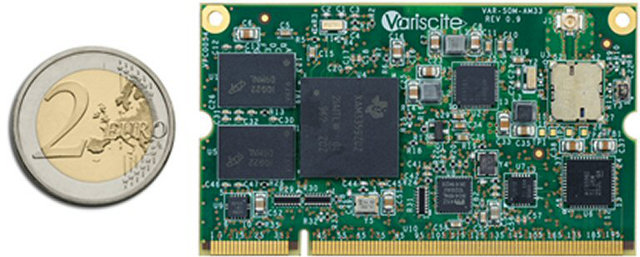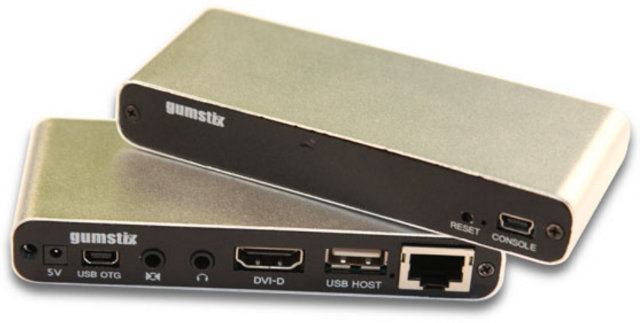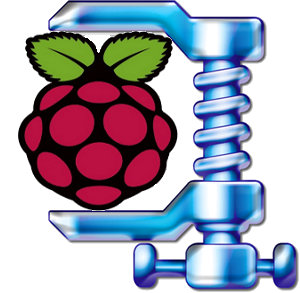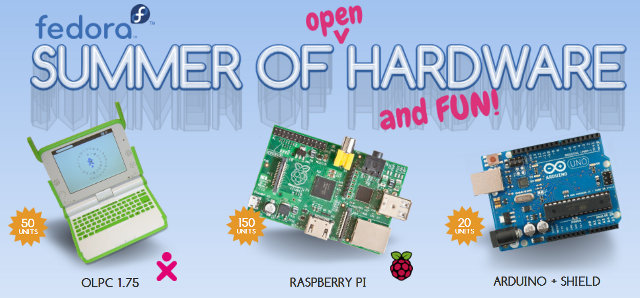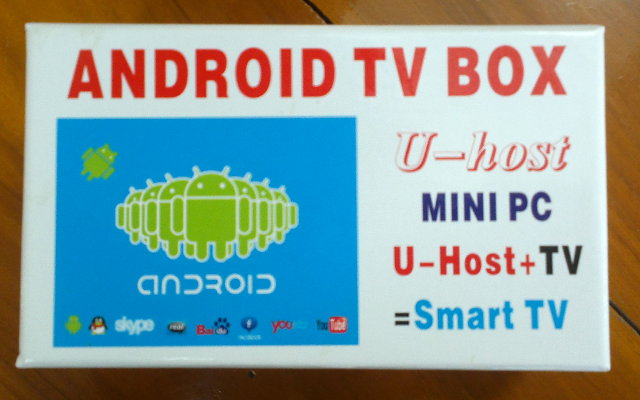An initramfs is a minimal root filesystem that is loaded at an early stage of the boot process, before the rootfs partition is mounted. This is optional but is now used by many Linux distributions such as Ubuntu in order to speed up boot time among others things. Up to recently, there was no support for this in the AllWinner A10 nightly builds, and there would be lot of error messages due to ureadahead process with Ubuntu, but I’ve changed that by: Using a boot.scr file (U-Boot Script) for each supported device in order to either follow the default init boot method or do an initramfs boot if uInitrd file is present in the FAT partition. Adding a script (a1x-initramfs.sh) to generate and install uInitrd initramfs in the rootfs. The initramfs can’t be generated at build time since the hardware packs are (mostly) distribution agnostic. If you want an initramfs, […]
$39 Variscite VAR-SOM-AM33 SoM Powered by TI Sitara AM335x
Variscite has announced a new system-on-module based on Texas Instruments Sitara Cortex A8 AM335x processors (AM3352 or AM3354) named VAR-SOM-AM33, which sells for as little as $39 US (in large quantities I assume). This SoM is available in commercial and industrial grades, and the company expects the module to be used in applications such as automotive, control systems, lighting, refining and processing. Here are the specs of this module: CPU – Texas Instruments AM335x Processor @ up to 720 MHz withPowerVR SGX530 GPU (AM3354 only) System Memory – 256MB 606MHz DDR3 Storage – 128 to 512MB SLC NAND Flash Display interface – LCD interface – Parallel RGB Supporting 1400×1050 24bit and4/5/8-Wire touch panel interface Audio – Line-in, line-out, stereo headphone out, digital microphone, analog microphone and S/PDIF Out Connectivity: 10/100Mbps Ethernet PHY 10/100/1000Mbps RGMII Wi-Fi 802.11 b/g/n (via TI WiLink 6.0) Bluetooth V4.0 + EDR (via TI WiLink 6.0) Interfaces: 2 […]
Gumstix Waysmall Silverlode Linaro Ubuntu Computer based on TI Sitara AM3703
Gumstix has just announced the Waysmall Silverlode computer, a small form factor device running Linaro ARM optimized Ubuntu and designed for developers of commercial and industrial applications such as digital signage players and remote servers. It’s based on Overo EarthSTORM Computer-on-Module (Texas Instruments Sitara AM3703 @ 1 GHz, 512MB Flash and 512MB RAM) and consumes less than 2.5 W. Here are the specs of the device: Processor Texas Instruments Sitara AM3703 processor (ARM Cortex-A8 ) @ 1 GHz 800 MHz is recommended for reliable performance System Memory 512 MB RAM Storage 512 MB NAND flash microSD card slot Video Output HDMI (DVI-D) Audio I/O Stereo Audio In /Out jacks Connectivity 10/100Mb Ethernet USB USB Host, USB OTG and USB Console Connectors 2 x 70-pin AVX connectors 1 x 27-pin Hirose camera connector Battery holder for 6mm rechargeable coin Dimensions 11.0 x 4 .4 x 1.8 cm Power 5V The computer […]
84 MB Minimal Raspbian ARMHF Image for Raspberry Pi
Many embedded systems applications do not require a desktop environment or graphical interface on the screen (e.g. server), and you may want to only install the files you really need on the SD card either to reserve as much space as possible for data and/or your program or to reduce costs. After searching for a minimal image based on Raspbian ARMHF distribution for the Raspberry, I could only find Linux Systems minimal image based on the Alpha version of the Raspbian Wheezy. Their compressed image is 109 MB in size, has a custom kernel, sshd and ntpd are enabled, but the wireless tools were deleted, and at the time the swap was located in another partition instead of a file inside the rootfs. The uncompress rootfs is about 414 MB (as reported by df -h when mounted as a loop device). I decided to prepare a minimal image myself based […]
Fedora To Give Away Raspberry Pis, OLPC 1.75 Laptops and Arduinos to Developers
Fedora will give away over 200 open hardware devices as part of its Summer of Hardware initiative to Fedora contributors. 150 Raspberry Pi boards, 50 OLPC 1.75 laptops and 20 Arduino boards and shields will be freely distributed to randomly selected candidates. In order to qualify, you must have a Fedora Project account, have signed the Fedora Project Contributor Agreement, be a member of at least one non-CLA / FPCA Fedora Group and be resident in one of the following country/region: Australia (excluding the states of New South Wales and the Australian Capital Territory), Belgium, Canada (excluding Quebec), Germany, India, Japan, the Netherlands, New Zealand, Singapore, South Korea, Spain, Sweden, United Kingdom, or the United States (excluding New York and Florida). To apply, you need to fill an application form by the 15th of August where you select your preferred device and enter your full name, Fedora account information and […]
Smallart U-Host mini PC Unboxing and Review
I’ve just received a Smallart Uhost mini PC based on AllWinner A10 from the “The Cubies hacker shop” on Aliexpress. The device features 1GB RAM, 4B flash, includes 802.11 b/g/n built-in, USB ports, HDMI output and a microSD card. It costs $70 including shipping. I received the device in the simple package below. There is a whole bunch of stuffs inside the package. A USB to mini USB cable for power and to connect the device to PC to act as a USB drive, the Smallart U-host mini PC itself, a user manual in English, the power supply 5V/2A with a USB port, an HDMI female to male cable. The USB to mini USB cable has actually 2 large USB connector in order to provide up to 5W power (2 x 500mA x 5V). The mini PC has several connectors including an HDMI male connector, a USB Host port (for […]
Linaro 12.07 Release with Kernel 3.5 and Android 4.0.4
Linaro has released version 12.07 based on Linux Kernel 3.5-rc3 and Android 4.0.4. Some work has been done on Jelly Bean (but the port is for next month), several benchmark tools have been added to LAVA as Linaro wants to provide standard benchmarks for Android, Linaro ALIP image now uses LXDE by default with a smaller image and improved performance, and Open Embedded images are now available (minimal and LAMP stack). Here are the highlights of the release: Android Jellybean baselines for Galaxy and Panda with Linaro extra’s available Android Benchmarking apps were deployed for pandaboard, snowball and origen in LAVA including: vellamo, quadrant, nbench, linpack, glbenchmark, geekbench, caffeinemark, antutu, andebench Improved native Benchmarks variance on Android to 1%, working on Java variance ICS “tests” builds now produced by default and test lists generated Open overlay tarballs working pm-qa’s cpuidle cpufreq cpuhotplug sched_mc suspend integrated into the Android builds Linaro […]
VIA Releases Kernel 2.6.32 and U-Boot Source Code for $49 APC Board
VIA Technology unveiled the low cost APC (Android PC) board based on WonderMedia WM8750 processor (ARM11) back in May, and started to ship the Android board this month (I think since that was their plan). The company has just released Kernel 2.6.32.9 and U-Boot source on github. Here’s how to retrieve the code provided git is already installed on your machine:
|
1 |
git clone git://github.com/apc-io/apc-8750.git |
You can then build U-Boot (provided you’ve already installed an ARM toolchain in your path):
|
1 2 3 |
cd $CURRENT_PATH/u-boot make wmt_config make all |
and the Linux kernel:
|
1 2 3 |
cd $CURRENT_PATH/kernel make 8710_defconfig make ubin |
The availability of the source means we should see Linux distribution like Debian, Fedora or Arch Linux ARM (separate from Arch Linux) running on the board very soon. In theory, it’s also possible to run a Linux distribution with the binary Linux kernel compiled for Android, but it causes some issues and also makes customization more difficult. I think they should also have release the code they modified […]



